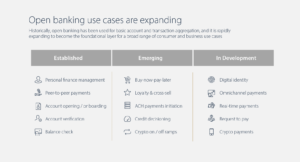
Whether banks know it or not, their customers may already be leveraging open banking technology.
If they pay friends using Venmo, transfer money from their account at your bank to websites like Robinhood to purchase stocks or use any other third-party financial applications that require a connection to their financial accounts, they are using open banking. Simply defined, open banking is a system that helps enable fast, innovative, and frictionless digital financial services.
Open banking creates a number of opportunities for consumers and businesses. Customer demand for seamless management of financial experiences has increased as they’ve grown accustomed to the benefits of personalized digital services. Research from Visa’s Open Banking Consumer Survey shows that 87% of U.S. consumers use open banking to link their financial accounts to third parties; however only 43% of U.S. consumers are aware that they are using open banking.
What is Open Banking?
Open banking is a system through which consumers or businesses authorize third parties, which can include any financial services organization like mortgage underwriter, banks or budgeting or trading app, to access their financial information or services. The third party may need the customers’ transaction or payment history or make a payment or requesting a loan on their behalf. Aggregators connect third parties to the financial accounts of consumers and businesses. When consumers or businesses share their financial data with third parties, the third parties can provide a number of products and services, including budgeting, credit checks or help initiating payments. Open banking enables consumers to connect financial accounts and share data securely.
How Does Open Banking Work?
Open banking is increasingly enabled by application programming interfaces, or APIs. Open banking APIs are specifically designed to link software systems and apps to securely communicate with each other. Financial institutions can establish these APIs to make consumer financial data available to third-party aggregators that serve as the bridge between account providers, like banks, brokerages and credit unions, and third-party applications, such as fintechs, merchants and other banks, that use this bank account data to provide financial services to consumers and businesses.
Open Banking Use Cases
A common, early use case is digitizing traditional financial management in a more efficient and secure way. But there is virtually no limit to the products and services that could be enabled by open banking.

Open banking enables financial institutions to improve their consumer experiences, illustrating the value of open access to financial information. Importantly, open banking could be a significant catalyst for financial inclusion and equity. The ability for all parties in the ecosystem to innovate and offer financial products to underserved communities could be considerably increased in a world where access to customer-permissioned information is easily available.
So while open banking is still in its early days, there are many potential opportunities and benefits that financial institutions should explore and consider offering to customers.

